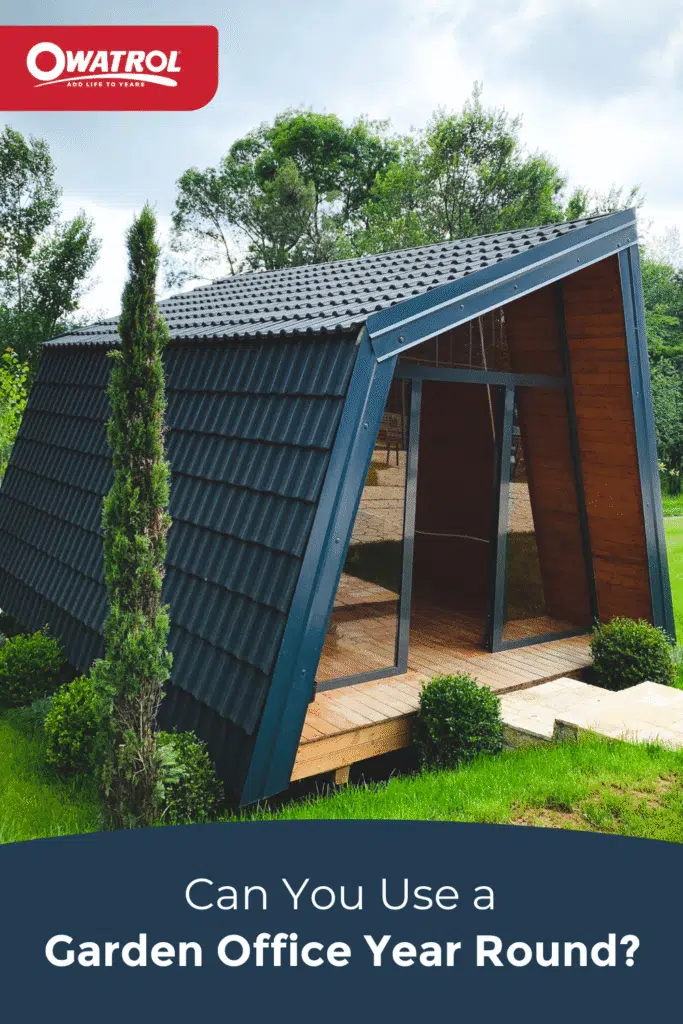Can a garden office be used all year round? The short answer is yes! If this is something you use every month of the year, you can make it happen.
However, there are things you will need to do to make sure it is safe and comfortable to use, no matter the weather. The following is what we will be covering:
- Keeping your garden office cool in the summer
- Keeping your garden office warm in the winter
- Understanding U-Values
Overview
There are a few things to consider when it comes to using a garden office all year round. Arguably, the most important thing you can do is install proper insulation.
In fact, a properly insulated garden office will keep it cool in the summer as well as warm in the winter. Not only that, properly installed insulation will reduce noise and help give necessary soundproofing.
Keeping your garden office cool in the summer
Although most summers seem to only last a few days, it can be very uncomfortable to work from a scorching hot office. There are a few things you can do in regards to keeping your office cool in the summer:
- Use a fan or a portable AC unit
- Open door/s and window/s
- Install a heat reflective blind
- If possible, reduce appliance use – e.g. if you have multiple monitors or a TV, perhaps try turning these off on those extra hot days to reduce heat emission.
A mix of one or two of these things will usually be sufficient for those really hot days.
Keeping your garden office warm in the winter
If your garden office is properly insulated, then you are halfway there. Below we list out the three most common ways in which to add a heat supply, along with their pros and cons:
An electric convection heater
Pros: Gets hot fast. Can be fairly inexpensive to purchase. Can have a small footprint. Some come with a timer feature.
Cons: Needs to be clear of obstruction and so must have space around it. Can cause the air to be quite dry. Some can be noisy. Can be expensive to run.
An oil filled radiator
Pros: Can be energy efficient and cheap to run. Will continue to heat the room after being turned off. A great option for large spaces. Uses less energy than an electric heater.
Cons: Can take a while to heat up (up to 15 mins). Fairly large footprint (at least when compared to an electric heater). Heavy and difficult to move around.
Underfloor heating
Pros: Energy efficient. Zero footprint so full flexibility as to its location. Zero maintenance. Safest and arguably most comfortable option.
Cons: Can be expensive to install retroactively. Ideally needs to be fitted during construction.
Understanding U-Values
This is the part that can be a bit trickier to get to grips with, but is a very helpful tool once you know about it.
A U-value is a term used in construction that measures the insulation qualities that make up a building. The more effective a material is at preventing heat loss between the inside and outside of a building, the lower the U-value.
In other words, having a low U-value will mean that less energy is required to maintain a comfortable condition within the building.
Over recent years, the UK’s building regulations have lowered the U-value requirements for buildings, in the hopes of helping to highlight a bigger awareness of sustainability, especially as energy prices rise. This in turn has caused suppliers to meet new demands for better insulating materials to be made available.
How to measure a U-value
A U-value is measured in watts per square metre, per kelvin (W/(m²K)).
As an example, a typical double glazed window has a U-value of 2.8 – this means that for every degree difference in temperature between the inside and the outside of the window, 2.8 watts will be transmitted every square metre.
Most off the shelf garden offices will display the U-value of the building on their specification sheet. The typical elements that have their own U-value in a garden office are:
- Walls
- Floor
- Ceiling/Roof
- Windows/Doors
To get an overall U-value for each element, you would combine all the layers of that specific area to bring a total value for that specific element. i.e, the floor will have a total U-value that is calculated from the U-vales of each of the materials that make up the entirety of the floor. This means you will take everything into account such as the flooring, the underlay, the insulation, the foundation base layer etc.
This makes comparison to a budling such as a shed or log cabin easy as they are usually made entirely of wood and although wood has fairly decent thermal qualities over other materials, it is inferior when compared to a garden office that can contain multiple layers of insulation, air pockets/cavities as well as timber to hold it all together.
Summary
To summarise, if a garden office is built correctly and thoughtfully, it can definitely be used all year round. For best results, we highly recommend not compromising on materials, especially if this is a space you will be working from for many years to come.
We also recommend you take the time to ensure that each component of the garden office meets your local council’s requirements.
We hope this post answered the question about using a garden office all year round. If you have any other advice or top tips, please feel free to leave them in the comments below. We love hearing from you!
You can also follow us on Twitter, Facebook, Instagram or Pinterest at @OwatrolUK or find us under the hashtag #OwatrolUK









